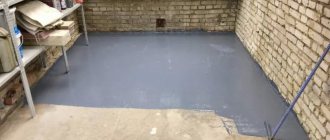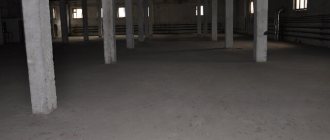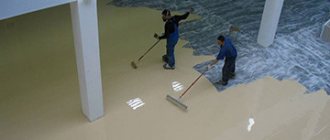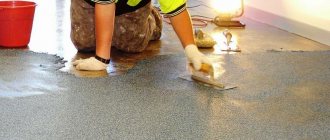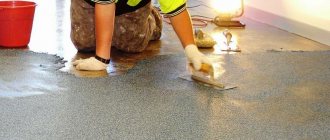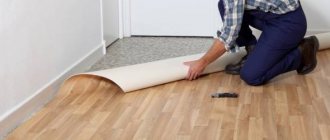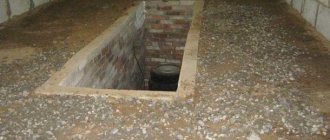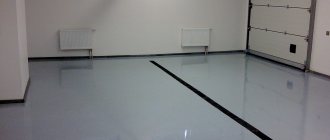Concrete floors are becoming an ideal solution not only in industrial settings; they are poured in a garage, workshop, basement, or on the ground floor of a private house. Due to the nature of the operation of concrete, a polymer coating for a concrete floor or other types of surface treatment becomes necessary. Let's figure out what materials are suitable for this task, what is the best way to cover the concrete base in order to extend its service life.
The absence of seams in the polymer floor facilitates the maintenance process Source design-homes.ru
Properties: why does a concrete base need protection?
The popularity of concrete floors in private construction is explained by the ease of making it yourself, using a minimal set of tools. The mixture includes a binder (cement), filler (gravel of various formations, sand, stone chips), improving additives and water, which makes the material affordable. The owners make a choice in favor of a concrete coating, taking into account other advantages of the material:
- Reliability, mechanical strength and long service life.
- Resistance to aggressive environments.
- Fire safety.
- Easy care.
However, the concrete surface begins to lose homogeneity over time, which is associated with two processes:
- Changes in temperature and humidity reduce the strength of the top layer, microcracks form on it, and then potholes appear.
- The porosity of the material, the release of salts to the surface, as well as its low tensile strength lead to the fact that under load the top layer begins to peel off. That's why the concrete floor gets dusty.
The garage floor is subjected to serious stress Source pinimg.com
The appearance of dust is a ubiquitous phenomenon, but most often it becomes obvious to the owner only after the floor has begun to be used. This situation is unacceptable not only for production, but also for a home garage or workshop.
To get rid of dust, special coatings for concrete floors are used. It is best to prevent the problem at the construction stage: after the concrete mixture has hardened, treat the surface with paint or another composition. As a result of the treatment, the pores on the surface will be clogged, and the wear resistance of the coating will improve.
In practice, several methods are used to protect concrete surfaces using different materials and technologies. Their diversity is enough to choose the most appropriate and effective option for specific conditions.
The need to use impregnations for concrete
Concrete is a porous material. Its strength depends largely on the hydration process of cement. As a result of this process, the pores of concrete may contain the gel substance of the cement mortar, moisture and air. All this negatively affects concrete during operation.
The presence of micropores causes two main disadvantages of this material:
- low hydrophobicity. Moisture seeps through the pores;
- insufficient concrete density, which reduces the strength of the finished floor.
Modern technologies make it possible to transform the porous structure of concrete and turn it into waterproof stone, which is especially important when creating concrete surfaces in contact with moisture.
The following problems are solved with the help of concrete impregnations:
- protection of concrete surfaces from chemicals and negative environmental factors;
- increasing the strength of concrete;
- increasing the wear resistance of concrete surfaces;
- dust removal of concrete structures;
- strengthening aged concrete structures;
- increasing the service life of concrete surfaces;
- improving the appearance of concrete floors.
Topping systems
Topping is a dry mixture used to harden the surface of a concrete floor (another name is hardening mixture). The technology has the following features:
- The mixture is applied to fresh concrete (immediately after laying). It is distributed over the surface; for large areas, a distribution machine is used.
Grouting industrial concrete floors Source mpkm.org
- Topping consumption depends on the expected load. If the load is small or medium, use approximately 3 kg/m². For medium or heavy loads, the flow rate is increased to 4-5 kg/m².
- The mixture absorbs moisture from the concrete mixture and darkens, after which it is pressed in with a trowel. The topping becomes one with the concrete base.
The basis (binder) of the topping, like concrete, is cement. Fillers are responsible for the functional properties: quartz, corundum (mineral or synthetic), iron carbide, and other compounds. Chemical plasticizer additives control the filling and shrinkage process. Thanks to coloring pigments, the topping can obtain any shade and texture (smooth or grainy), so it is convenient to use as a topcoat.
The use of topping systems has a beneficial effect on surface characteristics as follows:
- Increases impact resistance and wear resistance. The service life of the surface increases several times, the risk of cracks and chips is significantly reduced.
Polished concrete screed in a garage Source nikastroy.ru
- Stops dust formation. The surface layer acquires a dense structure, becomes even and smooth. This facilitates dry and wet cleaning, which is useful from the point of view of hygiene and health.
- Light-colored toppings reflect light well, which allows you to save on lighting costs.
The use of toppings as a coating for concrete has the following limitations:
- It is more profitable to use dry mixtures in large areas (in workshops, warehouses, parking lots), where heavy equipment operates.
- They are not suitable for areas where chemicals are used (and spilled).
- In rooms with high humidity, sealing impregnations are additionally used.
Types of polymer coatings
When choosing a polymer coating, it is worth considering the following basic aspects: the purpose of the room and the types of loads acting on the base, the condition of the concrete floor, operating conditions, and the importance of decoration. To finish concrete floors, a variety of types of compounds are used, supplied by many manufacturers.
Impregnations
Used for premises for various purposes. Typically, concrete floors are coated with impregnations before the finishing layer is installed. To ensure maximum durability and strength of a polymer floor, it is necessary to increase the adhesion of the concrete and polymer layers. If an inappropriate composition is chosen for these purposes, the future floor may become cracked and deformed.
Floor impregnation is a homogeneous liquid mass that contains a binder polymer, certain fillers and a number of special additives.
The main functions of impregnations:
- Filling all small pores of concrete.
- Ensuring reliable adhesion of materials to each other.
- Dust removal and strengthening of the base.
A correctly selected primer guarantees a longer service life and increased adhesion, so it’s definitely not worth ignoring this stage of work or skimping on impregnation.
Polymer
Organic-based impregnations remove dust from the concrete floor, penetrate into the concrete base to a depth of 2-6 millimeters, efficiently fill and securely bind the pores of the top layer. Thanks to this, concrete becomes more resistant, durable, and able to withstand the effects of various negative factors.
Polymer impregnations are produced on the basis of epoxy, acrylic, PVC, and polyurethane substances. The composition makes it possible to eliminate the risks of repairs and equipment shutdowns due to contamination and dust. Coatings become resistant to aggressive environments, mechanical loads, and are easier to clean.
The characteristics of concrete coated with polymer impregnation are close to those of polymer concrete floors - impact strength is doubled, abrasion resistance is increased by up to 10 times, and grade strength is increased several times. It is also important that impregnations are able to seal the surface, prevent dusting and chipping of fillers.
Acrylic
This type of composition does not have a very long service life and requires updating every 2-3 years. Typically, acrylic impregnations are used where there are not too heavy loads. They prevent dust well and are resistant to moisture and ultraviolet radiation. Consumption averages 0.2-0.35 liters per square meter.
Polyurethane compounds
The most economical and popular type of impregnation for concrete surfaces. The compositions significantly increase strength, wear resistance, moisture resistance, guarantee complete dust removal and significantly improve the appearance of the base. The main disadvantage of polyurethane compounds is the presence of a pungent odor and prohibition of use when the base humidity is above 5%. Consumption is 200-400 grams per square meter (single-layer coating).
Epoxy
Two-component epoxy impregnations perfectly remove dust from concrete and reliably protect against moisture and the effects of fuels and lubricants. Impregnation gives a slightly lower load resistance compared to polyurethane compounds, but does not imply any odor. The consumption of the substance is 200-300 grams per square meter.
Relatively recently, water-based epoxy compounds have appeared on the market, which are characterized by reduced viscosity, and therefore penetrate much better into the surface layers of the concrete monolith.
Latex
Substances based on latex cope well with dust formation, are resistant to ultraviolet radiation, and create a protective coating that is not afraid of aggressive environments and abrasives. They are odorless as the solvent in the composition is water. Impregnations can be applied even to fresh concrete. But they are not used to cover floors that experience increased loads.
Based on PVC resins
This type of substance provides deep penetration into the surface layer of concrete, reliably protecting it from abrasion and stress. Impregnations dry quickly and resist aggressive influences and environments well, but their ability to repel dirt is low.
On average, 200-350 grams of composition are used per square meter. Pigments are often added to impregnations to add color to the floor and increase decorative properties.
Polymer paint
The paints are applied in thin layers of 500 microns, so they are suitable for surfaces that do not involve too high loads. Before applying paint, the concrete floor is coated with special impregnations. The best option for creating a beautiful and reliable floor is to apply impregnation, primer and then paint. Today, Moscow and the regions provide a large selection of compositions, so selection difficulties should not arise.
Key tasks when painting concrete floors:
- Decorative and aesthetics – giving concrete a certain shade, which significantly improves the floor.
- Protection - applying paint significantly extends the service life of the floor, increases resistance to aggressive and atmospheric influences, moisture, increases hygiene and mechanical strength.
- Elimination of minor defects and cracks, smoothing out minor irregularities.
Types of paints for concrete floors:
- Epoxy
– resistant to abrasion and fuels and lubricants, increases strength and adhesion, can be applied to still wet concrete, suitable for external/internal work, hardens quickly (therefore work is carried out quickly). Usually the floor is covered in 2 layers, there is the possibility of pigmentation, but the choice of colors is not too wide. Consumption within 300 grams per m2, dries within 24 hours.
- Acrylic
– moisture-resistant, not afraid of high temperatures and ultraviolet radiation, odorless, frost-resistant, can be used for interior/exterior work, relatively inexpensive, suitable for floors with light loads. Usually applied in 2 layers, the finish of the coating can be glossy, matte, semi-matte, consumption is in the range of 300-400 grams per m2, dries up to 3 days.
- Polyurethane
– demonstrates resistance to chemical influences, as well as mechanical damage and shock, can be used for interior/exterior work, gives a glossy or matte finish, and demonstrates good decorative and hiding properties. This paint is quite expensive, consumption is about 400 grams per m2, dries within 1-2 days (but gains full strength within 14 days).
- Rubber
– demonstrates resistance to various atmospheric phenomena, mechanical damage and abrasion, environmentally friendly and elastic, moisture resistant, suitable for application at sub-zero temperatures and high temperatures, hiding power is not very high, but decorativeness is excellent. The cost of paint is quite high, consumption is 100-200 grams per m2, applied in 2 layers, can be colored, dries in 40-50 minutes.
- "Polymer stone"
is a popular new coating that is applied in a thin layer to old and newly poured concrete floors. The composition extends the service life, penetrates deep into the pores of the material, making it resistant to various types of influence. The coating can be applied without priming, the film is 150 microns thick, dries in 4 hours, after 24 hours the floor may experience increased loads.
Floors
Types of flooring can be different and each type has certain pros and cons, features and nuances. Before choosing one or another option, you need to study all the properties and characteristics.
Self-leveling floor
Self-leveling mixture, the thickness of which is usually 4-5 millimeters. The liquid composition is poured onto a leveled and repaired or completely hardened concrete surface, leveled independently, creating a monolithic coating with high strength and durability characteristics.
The surface can be smooth or textured, include mineral particles, and suggests the possibility of decoration.
Polyurethane based
Such coatings are very popular today as they provide good chemical and physical properties.
Features of the use of polyurethane floors:
- Can be poured onto foundations that will experience large dynamic and static loads.
- The coating is not afraid of temperature changes, ultraviolet radiation, and retains elasticity and strength.
- Polyurethane flooring is non-slip, hygienic, and fireproof.
- Excellent decorative properties.
- Unpleasant aroma of the composition.
- The mixture cannot be applied to damp substrates.
Epoxy based
Epoxy floors can withstand medium loads, are often poured onto old screeds, and are also suitable for new ones (the solution can be applied to still wet concrete). The coating is not afraid of chemicals, aggressive influences, moisture, can be used outdoors, repels dirt well, and does not require special care. The base demonstrates excellent decorative properties, is fireproof, and environmentally friendly.
The solution is obtained by mixing the components; it must be used quickly and correctly. The coating is susceptible to impact loads, and cracks may appear when heavy objects fall.
Methyl methacrylate based
A relatively new type of coating, which is characterized by certain features.
Key properties of coatings based on methyl methacrylate:
- The two-component composition hardens quickly and is not afraid of moisture, impact or abrasion, temperature changes or aggressive environments.
- Loads are allowed up to 15 tons per square meter.
- The coating is difficult to work with and dries quickly, so it is usually only used by professionals.
- The composition releases toxic substances during installation.
- Flooring is quite expensive.
Highly filled polymer floors
During installation, this type of coating creates a super-strong base that can easily withstand heavy traffic loads, exposure to moisture, temperature changes, and aggressive substances.
The coating can be done outside/indoors. The thickness of the coating layer varies in the range of 4-10 millimeters. The composition of the mixture includes: quartz sand, polymer fixative, pigments (if you want to obtain a coating of a certain shade).
Primers, impregnations, primers
Primer (primer) is a material that is used for preliminary preparation of the surface (if you are then going to apply the finishing coat). Primers are often (and erroneously) called impregnations, which, in fact, are independent impregnating sealing materials.
All these materials are not external, but penetrating; their main advantage is that they help to quickly and efficiently remove dust from the floor in the garage.
Concrete surface needs dust removal Source ad-cd.net
See also: Catalog of companies that specialize in finishing materials and related work
The basis of primers and impregnations are film-forming substances (polymers). The compositions may be natural or synthetic. After application, they penetrate into the pores of concrete and strengthen the loose structure, binding it with polymer molecules.
As a result, concrete practically stops dusting and becomes stronger. It better withstands negative temperatures and exposure to accidentally spilled acids and alkalis. To strengthen the concrete coating, the following types of impregnating materials are used:
- Polyurethane. Suitable for both primer and finishing layers, improve waterproofing and protect against abrasion. The floor is treated twice, undiluted. The best polymerization result is obtained at moderate temperatures (0-17°C) and humidity not lower than 70%. Polyurethane primer is often used to repair surfaces, for which it is mixed with sand.
- Water-dispersed. A budget option, made on a water basis, there is practically no smell. The main property is dust removal, the surface is slightly strengthened. Before application, water-dispersion mixtures are diluted with water.
Applying primer mixture Source opscool.ru
- Epoxy. The main property of epoxy primers is waterproofing. Like any epoxy resin-based materials, these are two-component formulations that must be mixed immediately before application and used at temperatures from +5°C.
Recommendations for finishing a concrete floor
The topcoat should be applied to the prepared substrate. It is recommended to choose paint based on the type of room and its functional purpose. For places with possible mechanical damage and heavy loads, it is better to use paints with high wear resistance to ensure greater strength and reliability.
Thin-layer self-leveling cladding is treated with varnish components for a concrete base or polyurethane enamel. If we talk about how to cover a concrete floor in a garage, it is best to choose products based on epoxy enamels and solvents.
To correctly determine what to cover a concrete floor with, it is important to take into account all the technical characteristics of the material, the characteristics of the room and climatic conditions. You also need to pay attention to the cost of the coating, since in addition to the price of the material itself, you also need to calculate the installation costs if the finishing work is not carried out independently, but with the involvement of specialists.
How to dust a floor: the cheapest ways (2 videos)
Various products for coating concrete (37 photos)
Paints for concrete
Paints of various compositions are widely used among concrete floor coatings. Since they are classified as finishing coatings, the surface is prepared before application: cleaned and primed. This increases the service life of the coating; it is only important to choose a primer based on the same polymer as the dye.
Epoxy paint
Epoxy paint forms the hardest and therefore wear-resistant coating for a concrete base, which can be used both indoors and outdoors. Epoxy resin paint can be used on freshly laid concrete; This feature reduces construction time.
A floor coated with epoxy paint has the following advantages:
- High waterproofing and no dust.
- Resistance to chemically active substances (solvents, oils, gasoline, acids and alkalis).
Epoxy paint for concrete Source beton-house.com
- Simplified care. The paint fills the pores in the loose outer layer of concrete, the dirt remains on the surface and is easy to remove.
- Increased wear resistance, aesthetic appearance. The paint does not wear off over time, does not turn yellow under the influence of ultraviolet radiation, and is convenient to use for marking.
Acrylic
Acrylic paints are mostly water-based, although there are more durable solvent-based options. The basis of the composite composition is polymer and acrylic resins, which form a durable, elastic and moisture-resistant polymer film.
To obtain the best result, the paint is applied to a dry floor, previously strengthened with acrylic primer (drying time up to 6 hours). It is applied in two steps, with a drying interval of 2 hours. Concrete coated with acrylic paint has the following advantages:
- Quick results. Less than a day passes from applying the primer to the start of operation.
- The base does not require leveling or perfect preparation.
- When dry, the acrylic layer acquires a dense matte texture, which visually evens out the base.
Acrylic paint for concrete floors Source beton-house.com
- The paint is affordable, and there are matte and glossy varieties on sale.
- Acrylic paint is easy to work with: applied with a brush, roller or spray, depending on the scale of the work.
Review of impregnations from different manufacturers
Currently, manufacturers offer a huge range of concrete impregnations of various types. This section presents those that have gained a good reputation among builders and are very popular.
Strengthening primer for concrete floors Protector.
This composition strengthens the concrete surface, removes dust and improves the resistance of concrete to chemical reagents.
Impregnation Protector is used in the construction of concrete surfaces for a wide variety of purposes: floors, roads, pedestrian paths, runways. The composition is produced in containers of 20 liters. The cost of 1 liter is 180 rubles.
Strengthening impregnation Retroplate
It is used for dust removal and strengthening of low-quality concrete (less than M300), as well as old and new mosaic floors.
When working with this impregnation, the following nuances must be taken into account:
- impregnation cannot be used on uncured concrete (at least 14 days must pass after pouring);
- The composition is applied at an air temperature of at least +5 degrees.
The composition is produced in 20 liter buckets. The price of one liter is approximately 400 rubles.
Organic impregnation Protexil
Designed specifically for treating floors in industrial facilities. It perfectly protects the concrete floor from aggressive environments, high mechanical and transport loads.
Technical and operational characteristics of Protexil:
- penetration depth – 5-10 mm;
- material consumption – 0.3 liters per square meter;
- operating temperature range – from -40 to +80 degrees;
- drying time is up to six hours at a temperature of +20 degrees;
- the cost of impregnation is 170-190 rubles per liter.
Universal impregnation Monolit 20-M
This is a water-based composition, so it is environmentally friendly and non-flammable.
Impregnation acts on a concrete floor as follows:
- increases the water resistance of concrete by three grades;
- increases wear resistance and hardness by 30%;
- reduces concrete warping and the formation of shrinkage cracks;
- removes dust from concrete;
- improves concrete adhesion;
- increases resistance to organic acids and petroleum products.
The impregnation consumption of Monolith 20-M is one liter per 3-5 square meters (depending on the porosity and condition of the concrete). The price of one liter is 130 rubles.
Impregnation Aquastone
This impregnation provides dust removal and surface protection for concrete, mosaic floors and cement-sand screeds. It exhibits excellent penetration, providing high strength and hardness to the concrete surface. Recommended for use on both industrial and domestic floors. It can be applied to substrates with high humidity. The price of one liter is 220 rubles.
Impregnation Aquasol
Impregnation is a water-repellent composition and is used to protect any cement-based building materials from moisture and other harmful atmospheric influences. One liter of this impregnation costs 210 rubles.
Impregnation Epoxol
It is an epoxy water-dispersed composition and is used for strengthening, dust removal and protection of concrete and magnesium floors, cement screeds. It increases the compressive strength of concrete by 2-3 times and prevents the formation of cracks. Epoxol can be applied to wet concrete. Recommended for strengthening floors in warehouses, pharmaceutical and food industries, public and residential premises, medical and children's institutions. The price of one liter is 380 rubles.
Impregnation Ashford Formula
The impregnation is a water-based silicate polymer. Recommended for strengthening concrete surfaces of indoor and outdoor areas of logistics terminals, warehouses, production workshops, markets, shopping centers, garages, parking lots, runways and other facilities with increased transport and pedestrian load. The cost of one liter is approximately 110 rubles.
Polyurethane
One way to protect the concrete surface and at the same time give it an attractive appearance is to use polyurethane dyes. Before applying polyurethane paint, the floor is prepared: dried, cleaned of dust, and oil (grease) stains are removed. Coloring is carried out in two stages, the second layer - no earlier than a day after the first.
The peculiarity of polyurethane-based paints is that they need from 2 to 14 days to dry completely. At the same time, the dye reaches a dry, tack-free state within a couple of days, after which small mechanical loads are acceptable.
During the remaining time, the polyurethane coating on the concrete floor continues to gain mechanical and chemical resistance. Using paint provides the following advantages:
- The dye is used for interior and exterior work and is highly resistant to weather vagaries.
Polyurethane two-component paint for industrial floors Source prom.st
Foam varnish
Paintwork materials that protect concrete also include polystyrene foam varnish for painting concrete floors. It is easy to prepare at home. Do-it-yourself paintwork will have the same properties as the finished product, and the cost will be an order of magnitude lower. To prepare polystyrene foam varnish for painting a concrete floor you will need:
- 0.5 l of acetone (or gasoline);
- 0.25 l xylene;
- a piece of foam plastic measuring 60x60 cm.
Then perform the actions in the following order:
- We break the foam into small pieces for quick dissolution.
- Pour acetone and xylene into a metal container.
- Pour a portion of foam pieces into the jar. We press them with a wooden stick to immerse their solvent.
- The foam will begin to quickly dissolve and the liquid will thicken. In this case, there will be an active release of gas contained in the foam.
- As it dissolves, add a new portion of pieces. To speed up the process, shake the container periodically.
- When all the foam has dissolved, close the container with a lid and leave to infuse.
- When the polystyrene varnish has set, paint the concrete floor with a brush or spatula.
How to paint concrete surfaces
In fact, it is important to know not only how and with what to paint a concrete floor, but also how to prepare the surface for applying the material. After all, the quality of painting largely depends on the preparation of the concrete base.
Preparation
Before performing any actions with the screed, it must be inspected, cleaned and cracks repaired. It is better to remove old paintwork using a spatula or a grinder. Then use a vacuum cleaner to collect debris and dust.
Primer
If a concrete floor enamel manufacturer recommends pre-priming, it must be done. Some primers are applied in two layers.
Important! When choosing a primer, you need to consider its compatibility with the dye being applied.
Primer application
To prevent dust formation and better adhesion of paintwork materials to the base, a special composition is applied - a primer. It penetrates deeply into the concrete structure, helping to compact the rough surface. As primers dry quickly, they lose their sticky properties. Manufacturers produce primers in two forms - ready-to-use and concentrated. Primers of this type are bitumen, polyurethane and epoxy.
Today different types of this material are produced. Each type has different performance characteristics, so you need to use a material suitable for concrete surfaces. Regardless of the type of material selected, when applying a primer, the following actions are performed:
- Before using the finished mixture, stir it thoroughly.
- A layer of primer is applied to a dry, dust-free base.
- After the first layer has dried slightly, repeat the application of the solution.
- Allow the primer coat to dry completely.
Alternative coatings for concrete
You can protect concrete from destruction, and yourself from dust, without resorting to impregnations and paints. Alternative coatings for concrete can provide an aesthetic appearance to the floor and provide practical protection even in difficult garage conditions. The following materials can effectively protect a concrete base:
- Ceramic tile. Durable, easy to clean and abrasion resistant material. The best quality solution for a garage would be clinker tiles; The floor can also be covered with porcelain stoneware. A practical solution would be an unglazed or embossed material with a high level of abrasion (class five). Regular ceramic tiles will not withstand garage conditions.
Porcelain tiles for garage floor cladding Source design-homes.ru
- Rubber tile. Modular tiles made from rubber crumbs are suitable for garages, car washes or auto repair shops. It is resistant to salt solutions, motor oils and alkalis, and does not slip when wet. A fallen part or tool will not damage the coating and will remain intact. Important advantages of the modules are wear resistance, ease of cleaning and a wide color palette.
- PVC tiles. In the garage, a lot of time is spent on cleaning, especially with the arrival of winter with its slush and salt stains. PVC tiles will simplify the problem; This is an unpretentious coating, more durable than paint and less expensive than tile. Its assembly does not require cementation, and it does not slip during operation. If one element gets damaged, it is replaced without disturbing the structure.
Modular rubber tile floor Source pinimg.com
- Rolled rubber for the garage (also mats). A variety of products made from rubber and rubber crumbs; used in garages, fitness rooms, on treadmills. Main advantages: quick installation, no slipping, low abrasion, long service life (up to 20 years), varied appearance.
Why is dust removal necessary?
Dust on a concrete base is caused by erosion of the material. First, the upper layers are subjected to this process, then the lower ones, and then not far from the destruction of the structure itself. In addition, concrete dust itself is harmful to humans. It causes diseases such as allergies, asthma and others similar to them.
But that's not all. Strong dust clogs the equipment, causing rapid abrasion of rotating parts and assemblies. The floor itself loses its original appearance due to dust, making the room less attractive in terms of aesthetics. Here you can add constant and frequent cleaning, and not only of the floor base, but of ceiling and wall surfaces. That is, concrete dust is a big problem. Therefore, dust removal from concrete is a necessary process, regardless of whether such a floor is the main base in the room or is a surface for further cladding.
Concrete dust is very harmful Source userapi.com
Self-leveling floors
This is the name of a special type of screed, for the production of which self-leveling mixtures are used. The main feature of the technology is the ability to create a coating of minimal thickness (up to 3.5 mm). Based on their use, self-leveling floors are divided into finishing and screeds; based on material, they are divided into mineral and polymer compositions, which differ in the pouring process.
A significant advantage of the technology (as opposed to cement screed) is its low labor intensity and high productivity. If the technology is followed, the mixture automatically levels itself to a horizontal plane. As a result, you get a durable and wear-resistant coating for concrete floors, the only disadvantage of which is its high cost.
Distribution of the mixture over the surface Source aviarydecor.com
Selection criteria: how to choose material
The garage floor is subject to significant loads and impacts. Not every material can withstand them. Therefore, it is important to make a responsible choice. Listed below are the basic requirements that must be met.
- Ability to withstand heavy weight. This is the weight of the vehicle and the heavy equipment used to repair it.
- Force. It must withstand mechanical damage from impacts and falling heavy tools.
- Strength and durability. A durable, wear-resistant material is needed so that repairs are not required too often.
- Resistant to moisture. During the cold season, which in some regions lasts more than half the year, snow and dirt remain on the body and wheels. Moisture that penetrates the floor should not damage it or cause the growth of mold or mildew.
- Fire safety. Combustible lubricants are flammable, so fire resistance is important for floors.
- Resistance to aggressive chemicals. Fuel, lubricants, maintenance and repair products are aggressive substances. The coating must be resistant to them and easy to clean in case of accidental contamination.
- Temperature stability. Garages are not always heated. In winter, during renovation work, the owner sometimes uses heating. It is important that the cladding does not crack or deform due to sudden temperature changes.
It’s good if the chosen floor covering is easy to care for. Many people would add price to the list of criteria. But these qualities are not decisive when choosing.
Video description
About the benefits of impregnation for concrete in the following video:
The basis of mineral self-leveling floors is a cement mixture; additives are fillers that determine performance characteristics. There are three types of mineral mixtures on the market:
- Basic. It is used for initial alignment (adjustment is needed afterwards). Scope of application: concrete foundations with a slope of up to 80 mm.
- Average. Foundations whose slope does not exceed 30 mm.
- Finish. Performs final leveling for subsequent flooring installation.
Polymer self-leveling floors are needed where increased demands are placed on the surface in terms of reliability, abrasion resistance, and resistance to chemical influences. Polymer coatings for concrete are classified according to the thickness of the material or the composition of the mixture. Based on the binding component, the following types are distinguished:
- Epoxy polymer self-leveling floor. It is particularly durable and inert to chemically aggressive environments. Sold as a two-component mixture including working resin and thickener. The best option for indoor spaces with high loads (garage, warehouse, workshop, shopping center).
Self-leveling self-leveling floor Source twimg.com
- Polyurethane. Its peculiarity lies in its higher shock-absorbing properties. In practice, such a base will be more resistant to tension and impact loads. The application technology is more complex than for the epoxy analogue and requires more experience.
- Methyl methacrylate. Methyl methacrylate flooring hardens very quickly; use can begin within 2-3 hours, including outdoors, and even in frosty conditions. The disadvantage of the material is its price; It is also extremely difficult to apply without skill, especially over a large area. After hardening, the floor is harmless, but during the application stage it is necessary to ensure good ventilation and protect the respiratory tract (true for some brands).
Self-leveling floors in loft style (with topping) Source mpm-pol.ru
Disadvantages of concrete floors
This material also has some disadvantages that should also be taken into account.
1. High thermal conductivity. Concrete easily transmits heat, and therefore heat can leave the room through such a floor. To prevent this from happening, when installing such a frame, a layer of insulation (sheet or granular) should be laid. And to ensure the most comfortable living conditions, a heated floor should be laid under the concrete screed.
2. High consumption of materials. Compared to other flooring materials, a concrete screed requires quite a lot of concrete mixture to form. Making batches manually with such volumes is quite problematic, and therefore you have to order a concrete mixer. And these are additional financial expenses.
3. Large weight of the floor. It should be noted that this material produces a rather heavy floor, which means it will create an increased load on the foundation.
4. Duration of hardening of the floor. This screed takes quite a long time to harden. The duration will depend on the strength of the concrete, but in general it can take from 3 to 28 days.
Briefly about the main thing
Concrete pouring is an ideal option for organizing the floor in a garage, basement, workshop or other utility rooms. But such a coating requires additional protection, since during operation the concrete wears out and forms dust. To extend the service life of concrete, various methods are used to protect its surface.
The compositions used include topping systems, primers (primers), impregnations and paints. Depending on the composition, acrylic, epoxy and polyurethane materials are distinguished. A separate type of coating consists of self-leveling floors, as well as floor materials: ceramic, rubber and PVC tiles.
What materials can be used to coat concrete?
An example of painting a concrete coating to protect it from abrasion.
The concrete base is a multi-layer structure that has good technical characteristics and “zero” decorative effect. To make it suitable for use, additional surface treatment is required, which would eliminate such drawbacks of the floor as the tendency to generate dust and absorb moisture. What materials are used to improve the technical and decorative properties of the floor?
- polymer impregnation;
- paints;
- putty;
- liquid glass;
- sealant.
The liquid composition, which is applied to the concrete surface, significantly reduces the porosity of the structure. This affects the following gender indicators:
- water absorption level;
- degree of sound insulation;
- susceptibility to chemical and mechanical damage;
- tendency to develop microorganisms (mold, fungus).
Additional protection significantly extends the life of the concrete floor. To understand which type of paint and varnish material is preferable to use, let’s consider the above-mentioned products in more detail.
Precast concrete slabs as a garage floor covering option
It is worth immediately noting that this option will require special equipment and a team of workers. This is also quite an expensive solution. The plus is that this material is reliable, durable and easy to install. The floor will be ready for use immediately after installation, you will not have to wait for it to dry.
However, if you lay the slabs directly on the ground, there is a risk that they will crack due to shrinkage of the base. And an increase in temperature can lead to their expansion and ultimately destruction. But all these problems can be solved by following the installation technique. The only question that remains is whether to use the floor in its current condition or to carry out additional treatment to protect it from oil and dust, as well as improve its aesthetic qualities.

